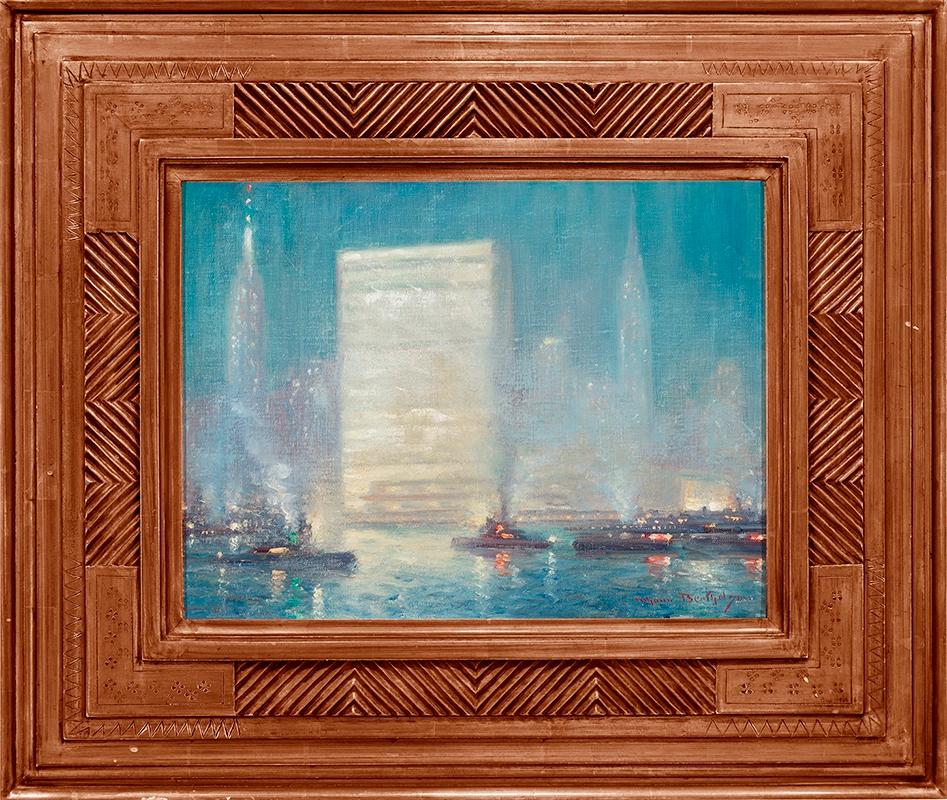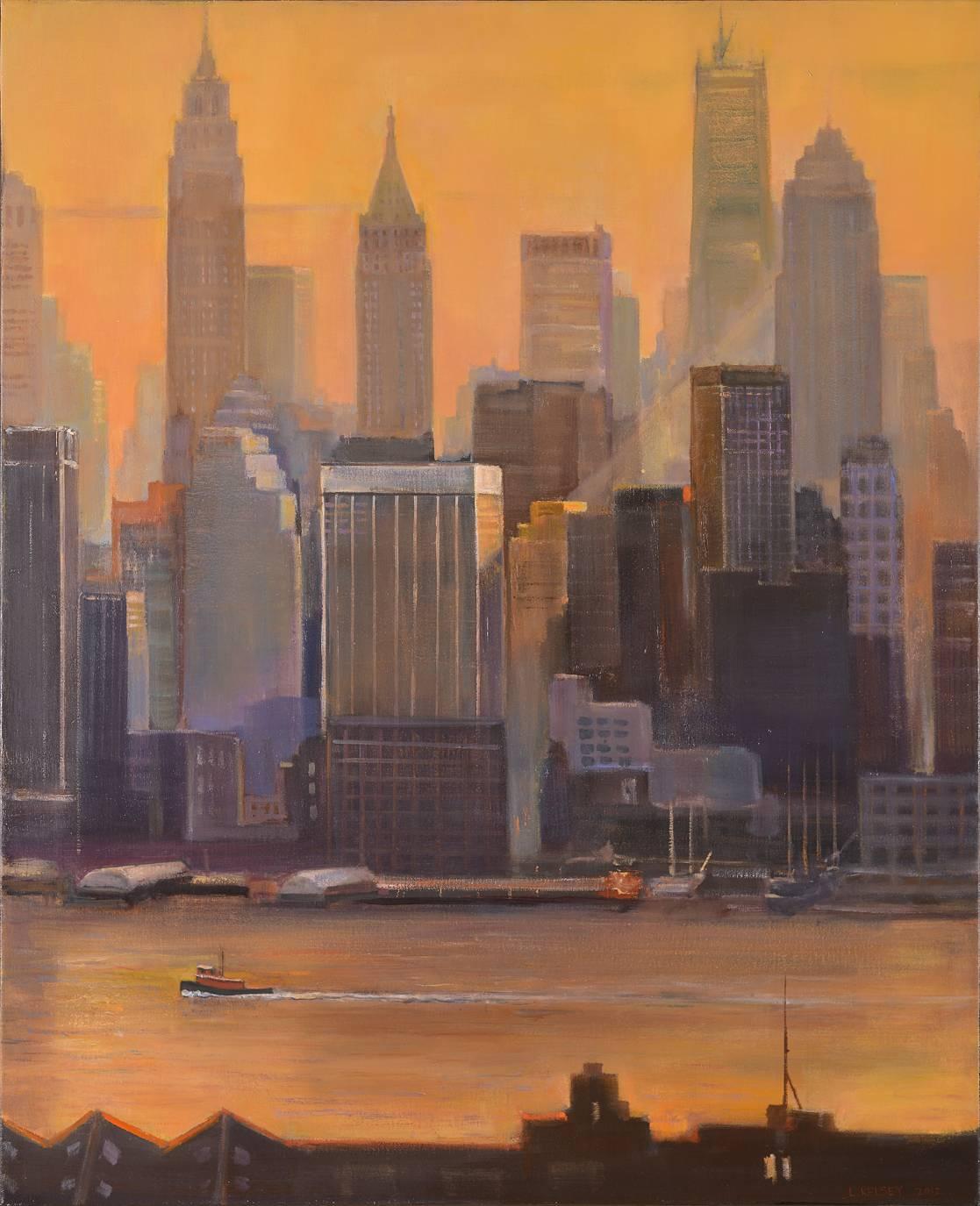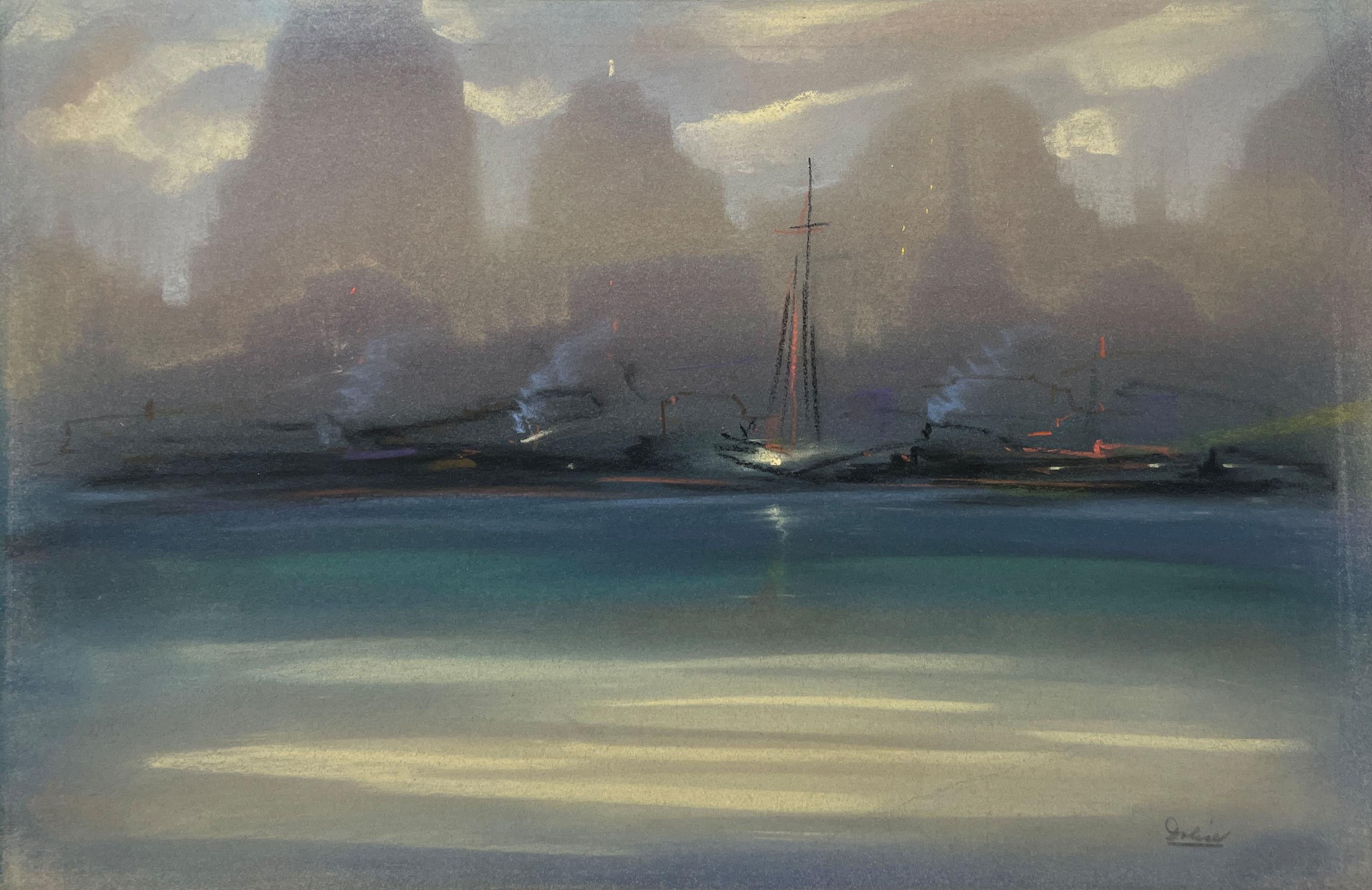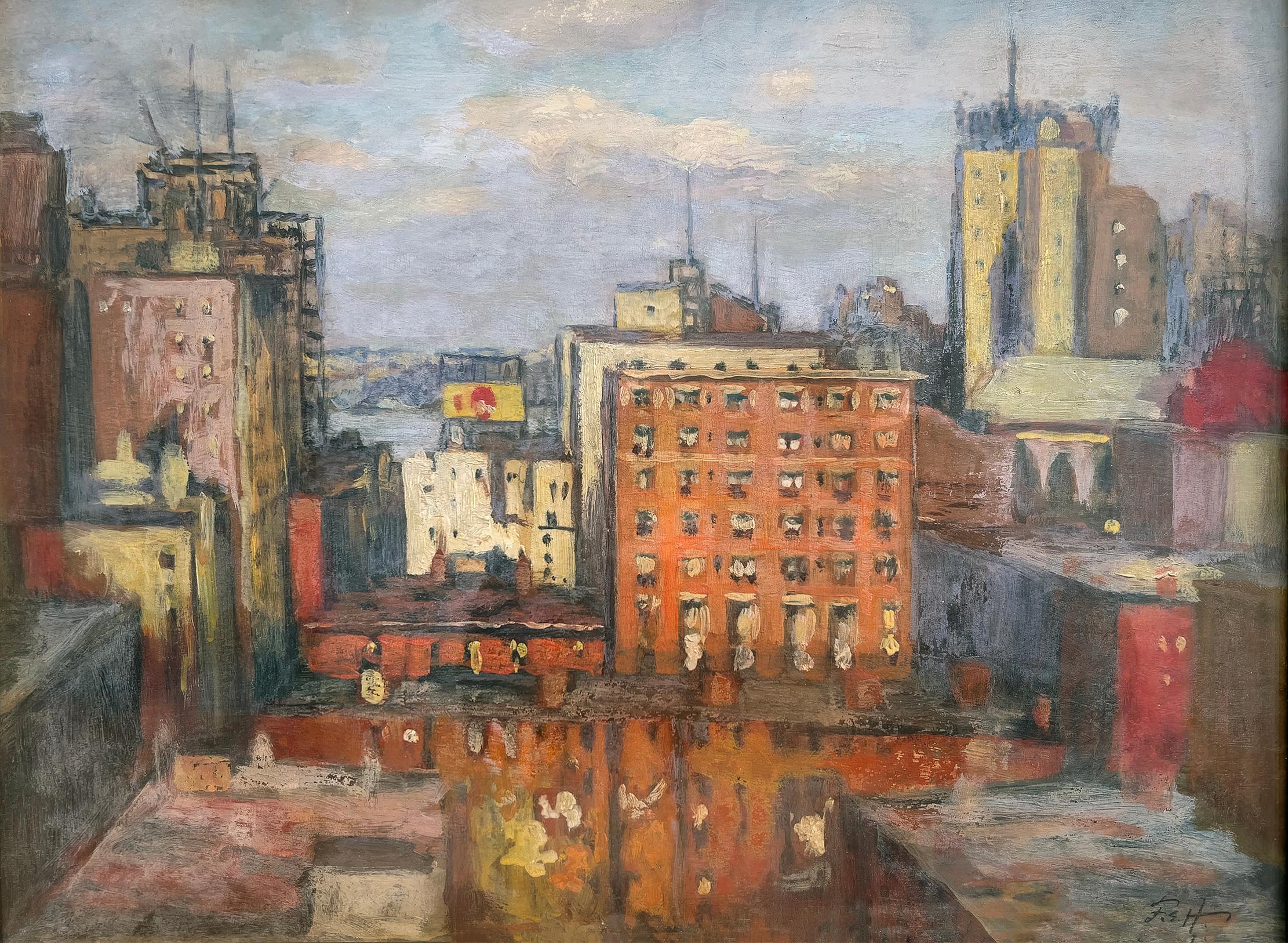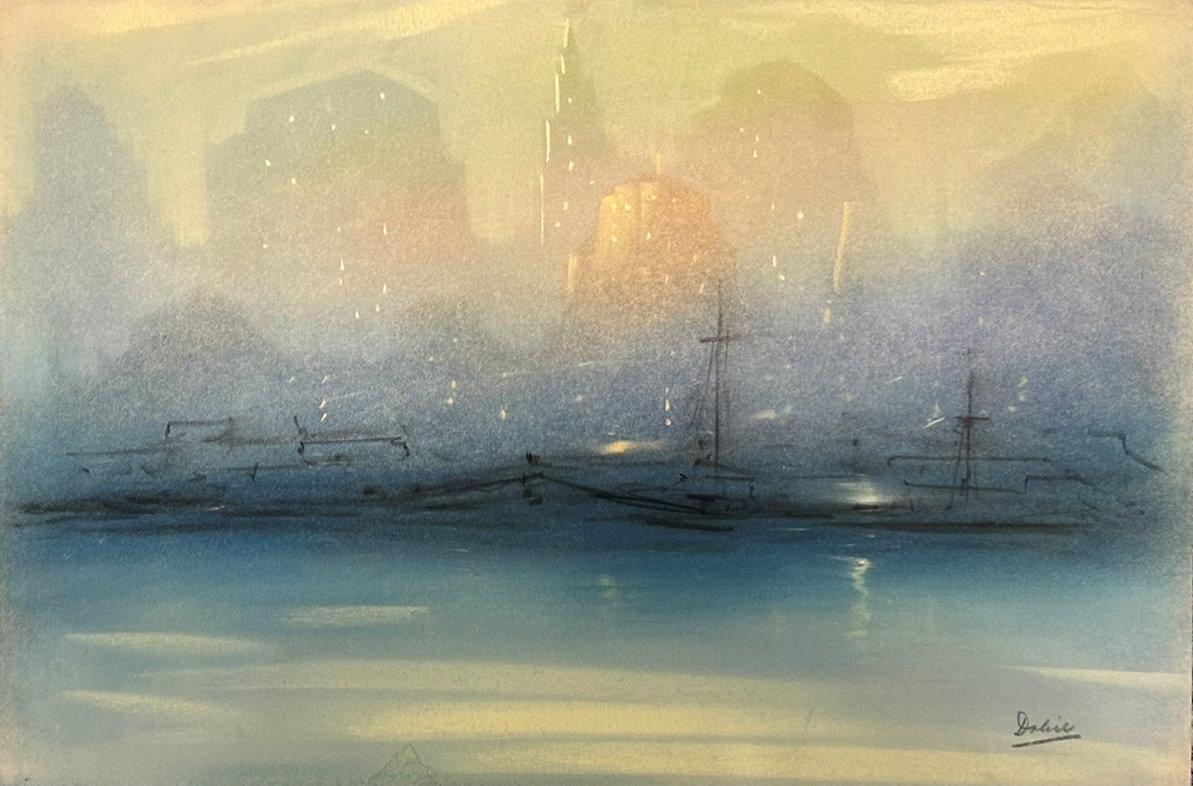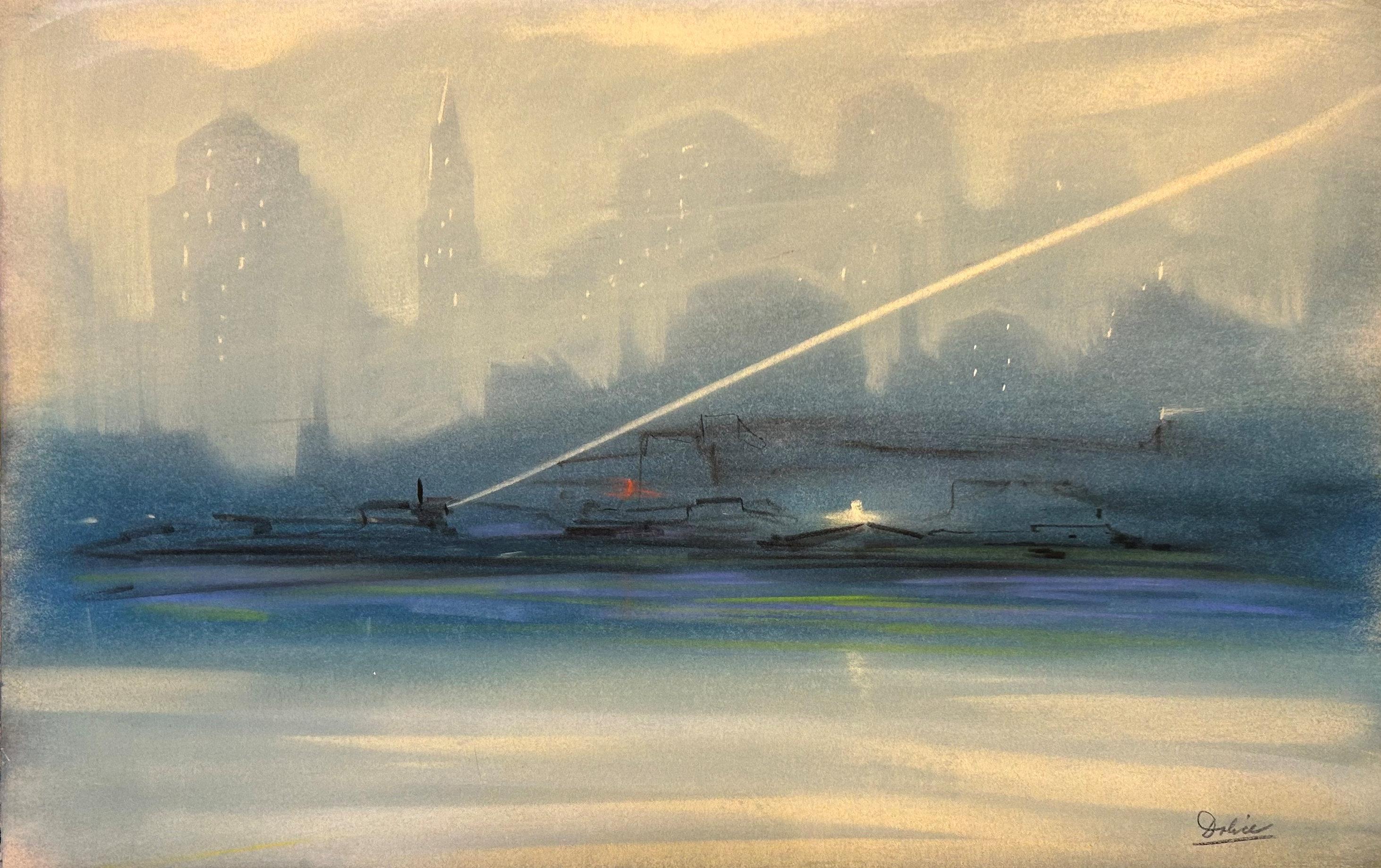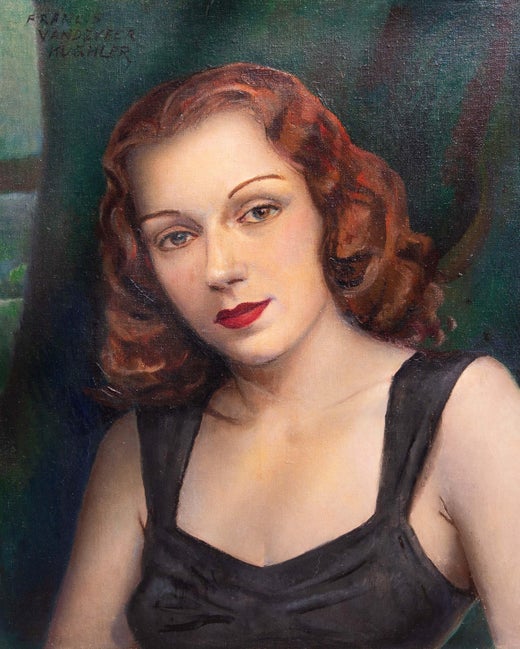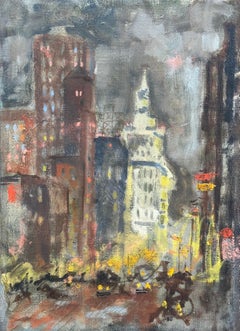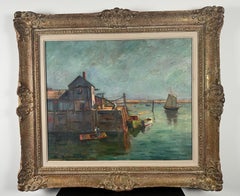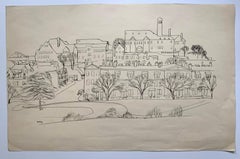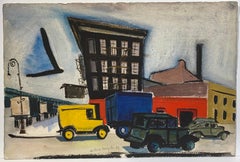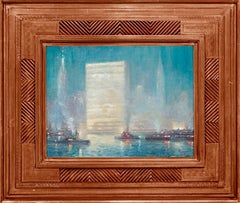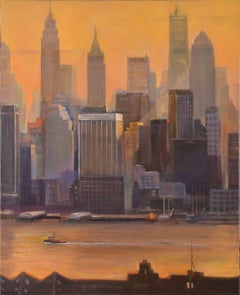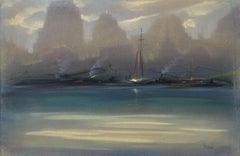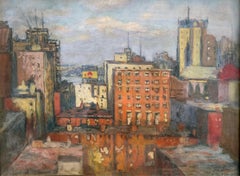Items Similar to Lower Manhattan at Dusk from New York Harbor
Want more images or videos?
Request additional images or videos from the seller
1 of 11
Francis Vandeveer KughlerLower Manhattan at Dusk from New York Harborca. 1940
ca. 1940
$8,000
£6,120.07
€7,038.79
CA$11,425.02
A$12,593.49
CHF 6,507.14
MX$150,546.29
NOK 81,859.42
SEK 76,936.20
DKK 52,573.57
About the Item
Francis Vendeveer Kughler (1901-1970. Manhattan Skyline from New York Harbor, ca. 1940. Oil on canvas mounted to masonite, 24 x 30 inches. Unframed. Excellent condition with no conservation. Signed lower right.
1901–1970
Born in New York City Kughler was educated in New York City public schools and art schools: De Witt Clinton High School, Cooper Union, the Mechanics' Institute and the National Academy of Design School of Art where he met Charlotte Livingston, an artist, whom he was later to marry. During this period he was the winner of a Tiffany scholarship, which provided him a summer of landscape painting at the Louis Comfort Tiffany estate at Oyster Bay, L.I.In the 1940s, Kughler became the President of the Salmagundi Club a well-known club in Washington Square in New York City that had been the singular gathering place for such great artists as Childe Hassam, William Merrit Chase, Howard Pyle, Carles Dana Gibson, Ogden Pleisner. During WWII, Kughler was selected by the Associated Press to paint memorials of six war correspondents who had been killed while reporting the news. Besides his work as a muralist and lithographer, Kughler was equally well-known for his cityscapes, landscapes, and nudes. He and his first wife, Charlotte Livingston, lived and worked in Bronx, New York. He later remarried.
- Creator:Francis Vandeveer Kughler (1901 - 1970, American)
- Creation Year:ca. 1940
- Dimensions:Height: 24 in (60.96 cm)Width: 30 in (76.2 cm)
- Medium:
- Movement & Style:
- Period:
- Condition:
- Gallery Location:Wilton Manors, FL
- Reference Number:1stDibs: LU24528889532
Francis Vandeveer Kughler
Born in New York City in 1901, Francis Vandeveer Kughler attended Cooper Union, the Mechanics' Institute, and the National Academy of Design School of Art where he met Charlotte Livingston, an artist, whom he was later to marry. During this period he was the winner of a Tiffany scholarship, which provided him a summer of landscape painting at the Louis Comfort Tiffany estate at Oyster Bay, L.I. In the 1940s, Kughler became the President of the Salmagundi Club, a well-known art club in Washington Square in New York City. Well-known as a muralist, society portrait painter and lithographer, he was a prolific painter who made cityscapes, landscapes, and nudes. He and his wife, Charlotte Livingston, lived and worked in Bronx, New York.
About the Seller
4.9
Platinum Seller
Premium sellers with a 4.7+ rating and 24-hour response times
Established in 2007
1stDibs seller since 2015
428 sales on 1stDibs
Typical response time: 4 hours
- ShippingRetrieving quote...Shipping from: Wilton Manors, FL
- Return Policy
Authenticity Guarantee
In the unlikely event there’s an issue with an item’s authenticity, contact us within 1 year for a full refund. DetailsMoney-Back Guarantee
If your item is not as described, is damaged in transit, or does not arrive, contact us within 7 days for a full refund. Details24-Hour Cancellation
You have a 24-hour grace period in which to reconsider your purchase, with no questions asked.Vetted Professional Sellers
Our world-class sellers must adhere to strict standards for service and quality, maintaining the integrity of our listings.Price-Match Guarantee
If you find that a seller listed the same item for a lower price elsewhere, we’ll match it.Trusted Global Delivery
Our best-in-class carrier network provides specialized shipping options worldwide, including custom delivery.More From This Seller
View AllSeventh Avenue (New York City Manhattan cityscape painting)
By George Luks
Located in Wilton Manors, FL
Beautiful Ashcan School era cityscape painting.
Seventh Avenue at Night, ca. 1920.
Oil on canvas, 8.75 x 12 inches.
On small patch repair on back.
Unframed.
Category
1920s Ashcan School Landscape Paintings
Materials
Oil
Rockport Landscape
By Giovanni Martino
Located in Wilton Manors, FL
Beautiful 1931 painting by American artist, Giovanni Martino (1908-1997). Oil on canvas measures 25 x 30 inches. Measures 35 x 39 inches framed. The scene depicts what is definitively the Rockport, Mass. fishing pier. Excellent condition with a few very minor areas of paint flaking. The darker areas in the sky is a result of unpainted areas. The canvas is sized with glue but not primed white: observable areas of natural linen color results. Signed wet into wet and dated lower left. No restoration or overpaint.
Giovanni Martino, National Academy of Design* member, was born on May 1, 1908 in Philadelphia PA where all seven brothers and one sister, Filomina, Frank, Antonio, Albert, Ernest, Giovanni, Edmond, and William became painters. They were under the tutelage of their eldest brother, Frank, who in the late 1920s, founded the first commercial art* studio, Martino Studios, at 27 South 18th Street.
Besides studying with his two eldest brothers, Giovanni also studied with Albert Jean Adolph at La France Institute, The Pennsylvania Academy of the Fine Arts*, The Graphic Sketch Club, and Spring Garden Institute in Philadelphia. In his mid teens he accompanied his two eldest brothers to New Hope searching for subjects to paint. In the 1930s, he also started to paint in Manayunk, a hilly mill town along the Schuylkill River...
Category
1930s American Impressionist Landscape Paintings
Materials
Oil
$1,440 Sale Price
20% Off
Cincinnati Ohio cityscape drawing WPA era
Located in Wilton Manors, FL
Beautiful original drawing by American artist, Albert Sway (b.1913). Cincinnati Cityscape, ca. 1935. Ink on paper measures, sheet measures 11 x 17 inches. Signed lower right. No da...
Category
1930s American Realist Landscape Drawings and Watercolors
Materials
Paper, Ink
North on West Street (West Side Highway NYC Cityscape)
By De Hirsch Margules
Located in Wilton Manors, FL
De Hirsh Margules (1899-1965). North on West Street , 1939. Watercolor on Arches wove paper. Signed and dated in pencil by artist lower margin. Sheet measures 15 x 22 inches. Framed measurement: 27 x 34 inched. Incredibly vibrant and saturated color with no fading or toning of sheet.
Provenance: Babcock Galleries, NYC
De Hirsh Margules (1899–1965) was a Romanian-American "abstract realist" painter who crossed paths with many major American artistic and intellectual figures of the first half of the 20th century. Elaine de Kooning said that he was "[w]idely recognized as one of the most gifted and erudite watercolorists in the country". The New York Times critic Howard Devree stated in 1938 that "Margules uses color in a breath-taking manner. A keen observer, he eliminates scrupulously without distortion of his material." Devree later called Margules "one of our most daring experimentalists in the medium"
Margules was also a well-known participant in the bohemian culture of New York City's Greenwich Village, where he was widely known as the "Baron" of Greenwich Village.[1] The New York Times described him as "one of Greenwich Village's best-known personalities" and "one of the best known and most buoyant characters about Greenwich Village.
Early Life
De Hirsh Margules was born in 1899 in the Romanian city of Iași (also known as Iasse, Jassy, or Jasse). When Margules was 10 weeks old, his family immigrated to New York City. Both of his parents were active in the Yiddish theater, His father was Yekutiel "Edward" Margules, a "renowned Jewish actor-impresario and founder of the Yiddish stage." Margules' mother, Rosa, thirty-nine years younger than his father, was an actress in the Yiddish theater and later in vaudeville. Although Margules appeared as a child actor with the Adler Family[11] and Bertha Kalich, his sister, Annette Margules, somewhat dubiously continued in family theater and vaudeville tradition, creating the blackface role of the lightly-clad Tondelayo (a part later played on film Hedy Lamarr) in Earl Carroll's 1924 Broadway exoticist hit, White Cargo. Annette herself faced stereotyping as an exotic flower: writing about her publicist Charles Bouchert stated that "Romania produces a stormy, temperamental type of woman---a type admirably fitted to portray emotion." His brother Samuel became a noted magician who appeared under the name "Rami-Sami." Samuel later became a lawyer, representing magician Horace Goldin, among others. A family portrait including a young De Hirsh, a portrait of Rosa and Annette together, and individual photos of Rosa and Edward can be found on the Museum of the City of New York website.
At around age 9 or 10, Margules took art classes with the Boys Club on East Tenth Street, and his first taste of exhibition was at a student art show presented by the club. By age 11, he had won a city-wide prize (a box camera) at a children's art show presented by the department store Wanamakers.
As a young teenager, Margules was already displaying a characteristic kindness and loyalty. Upon hearing that two friends (one of them was author Alexander King), were in trouble for breaking a school microscope, the nearly broke Margules gave them five dollars to repair the microscope . Margules had to approach a wealthy man that Margules had once saved on the subway from a heart attack. Margules didn't reveal the source of the five dollars to King until twenty-five years later.
In his late teens, Margules studied for a couple of months in Pittsburgh with Edwin Randby, a follower of Western painter Frederic Remington. Thereafter he pursued a two-year course of studies in architecture, design and decoration at the New York Evening School of Art and Design, while working as a clerk during the day at Stern's Department Store. He was encouraged in these artistic pursuits by his neighbor, the painter Benno Greenstein (who later went by the name of Benjamin Benno).
Artistic career
In 1922, Margules began work as a police reporter for the City News Association of New York .Margules then considered himself something of an expert on art, and the painter Myron Lechay is said to have responded to some unsolicited analysis of his work with the remark "Since you seem to know so much about it, why don't you paint yourself?" This led to study with Lechay and a flurry of painting.
Margules' first show was in 1922 at Jane Heap's Little Review Gallery. Thereafter Margules began to participate in shows with a group including Stuart Davis, Jan Matulka, Buckminster Fuller (exhibiting depictions of his "Dymaxion house") in a gallery run by art-lover and restaurateur Romany Marie on the floor above her cafe.
Jane Heap, left, with Mina Loy and Ezra Pound
During the 1920s, Margules traveled outside of the country a number of times. In 1922, with the intent of reaching Bali, he took a job as a "'wiper on a tramp steamer where [he] played nursemaid to the engine." He reached Rotterdam before he turned back. He would return to Rotterdam shortly thereafter.
In 1927, Margules took a lengthy leave of absence from his day job as a police reporter in order to travel to Paris, where he "set up a studio in Montmartre's Place du Tertre, on the top floor of an almost deserted hotel, a shabby establishment, lacking both heat and running water." He studied at the Louvre and traveled to paint landscapes in provincial France and North Africa.
Margules also joined the "Noctambulist" movement and experimented with painting and showing his artwork in low light.Jonathan Cott wrote that:
the painter De Hirsch Margulies sat on the quays of the Seine and painted pictures in the dark. In fact, the first exhibition of these paintings, which could be seen only in a darkened room, took place in [ Walter Lowenfels'] Paris apartment.
Elaine de Kooning remarked that studying the works of the Noctambulists confirmed Margules' "direction toward the use of primary colors for perverse effects of heavy shadow."
It was also in Paris that Margules initially conceived his idea of "Time Painting", where a painting is divided into sectors, each representing a different time of day, with color choices meant to evoke that time of day.
In Paris, his social circle included Lowenfels, photographer Berenice Abbott, publisher Jane Heap, composer George Anthiel, sculptor Thelma Wood, painter André Favory, writer Norman Douglas, writer and editor George Davis, composer and writer Max Ewing, and writer Michael Fraenkel.
Upon his return to New York in 1929, Margules attended an exhibition of John Marin's paintings.
While at the exhibition, he "launched into an eloquent explanation of Marin to two nearby women", and was overheard by an impressed Alfred Stieglitz. The famous photographer and art promoter invited Margules to dine with his wife, the artist Georgia O'Keeffe, and his assistant, painter Emil Zoler. Stieglitz thereafter became a friend and mentor to Margules, becoming for him "what Socrates was to his friends."
Alfred Stieglitz
Stieglitz introduced Margules to John Marin, who quickly became the most important painterly influence upon Margules. Elaine de Kooning later noted that Margules was "indebted to Marin and through Marin to Cézanne for his initial conceptual approach - for his constructions of scenes with no negative elements, for skies that loom with the impact of mountains." Margules himself said that Marin was his "father and ... academy." The admiration was by no means unreciprocated: Marin said that Margules was "an art lover with abounding faith and sincerity, with much intelligence and quick seeing." Stieglitz also introduced Margules to many other artistic and intellectual figures in New York.
With the encouragement of Alfred Stieglitz, Margules in 1936 opened a two-room gallery at 43 West 8th Street called "Another Place." Over the following two years there were fourteen solo exhibitions by Margules and others, and the gallery was well-respected by the press. It was in this gallery that the painter James Lechay, Myron's brother, exhibited his first painting.
In 1936, Margules first saw recognition by major art museums when both the Museum of Modern Art and the Museum of Fine Arts, Boston purchased his works.
In 1942, Margules gave up working as a police reporter, and apparently dedicated himself thereafter solely to an artistic vocation.
"The Baron of Greenwich Village"[edit]
Margules made his mark not only as an artist, but also as an outsized personality known throughout Greenwich Village and beyond.
To local residents, Margules was known as the "Baron", after Baron Maurice de Hirsch, a prominent German Jewish philanthropist. Margules was easily recognizable by the beret he routinely wore over his long hair. Writer Charles Norman said that he "dressed with a flair for sloppiness."
He was said to "know everybody" in Greenwich Village, to the extent that when the novelist and poet Maxwell Bodenheim was murdered, Margules was the first one the police sought to identify the body. Margules' letters show him interacting with art world figures such as Sacha Kolin, John Marin and Alfred Stieglitz, as well as with prominent figures outside the art world such as polymath Buckminster Fuller and writer Henry Miller.
Most of his friends and acquaintances found Margules a generous and voluble man, given to broadly emotionally expressive gestures and acts of kindness and loyalty. In 1929, he exhibited an example of this loyalty and fellow-feeling when he appeared in court to fight what the wrongful commitment of his friend, writer and sculptor Alfred Dreyfuss, who appeared to have been a victim of an illicit attempt to block an inheritance.
The Greenwich Village chronicler Charles Norman described the bone-crushing hugs that Margules would routinely bestow on his friends and acquaintances, and speaks of the "persuasive theatricality" that Margules seemed to have inherited from his actor parents. Norman also wrote about Margules' routine acts of kindness, taking in homeless artists, constantly feeding his friends and providing the salvatory loan where needed. Norman also notes that Margules was blessed with a loud and good voice, and was apt to sing an operatic air without provocation.
The writer and television personality Alexander King said
I think the outstanding characteristics of my friend's personality are affirmation, emphasis, and overemphasis. He chooses to express himself predominantly in superlatives and the gestures which accompany his utterances are sometimes dangerous to life and limb. Of the bystanders, I mean.
King also spoke with affectionate amusement about Margules' pride in his cooking, speaking of how "if he should ever invite you to dinner, he may serve you a hamburger with onions, in his kitchen-living room, with such an air of gastronomic protocol, such mysterious hints and ogliing innuendoes, as if César Ritz and Brillat-Savarin had sneaked out, only a moment before, with his secret recipe in their pockets."
Margules was such a memorable New York personality that comic book writer Alvin Schwartz imagined him at the Sixth Avenue Cafeteria in a risible yet poignant debate with Clark Kent about whether Superman had the ability to stop Hitler.
Margules' entrenchment in the Greenwich Village milieu can be seen in a photograph from Fred McDarrah's "Beat Generation Album" of a January 13, 1961 writers' and poets' meeting to discuss "The Funeral of the Beat Generation", in Robert Cordier [fr]'s railroad flat at 85 Christopher Street. Among the people in the same photograph are Shel Silverstein...
Category
1930s American Modern Abstract Paintings
Materials
Watercolor, Rag Paper
$6,000 Sale Price
20% Off
Cincinnati Ohio cityscape drawing WPA era
Located in Wilton Manors, FL
Beautiful original drawing by American artist, Albert Sway (b.1913). Cincinnati Cityscape, ca. 1935. Ink on paper measures 9.5 x 12 inches. Signed lower right. Good condition with no...
Category
1930s American Realist Landscape Drawings and Watercolors
Materials
Paper, Ink
Fisherman at Dusk
By Oskar D'Amico
Located in Wilton Manors, FL
Oskar D'Amico (1923-2003). Fisherman at Dusk, c.1960. Oil on linen canvas, 16 x 30 inches; 18 x 32 inches (frame). Signed lower right. Excellent condition with no damage or conservation.
Biography:
Oskar Maria D'Amico (February 22, 1923 – May 3, 2003) was an active Italian artist in Rome, Naples, Lanciano, Cisterna, Milan, Gallarate, Torino, Zagabria, Paris, Toulouse, Melun, Carenac, Maubeuge, Madrid, Barcelona, Zaragoza, Budapest, Győr, Mexico City, Cuernavaca, Morelia, Toronto, New York City, Philadelphia, Los Angeles, San Francisco, Miami, Denver, Santa Fe, Albuquerque and Socorro, between 1943 and 2003.
He is considered a Nomad artist because of his ability to work in various styles. He had three major periods in his artistic life: Figurative, Materic and Geometric. [1]He also was an outstanding art director for more than 75 epic movies. D'Amico had a very outgoing personality. He was a non-conformist, which was reflected in his work throughout his life. D'Amico was born in CastelFrentano, Italy, a small village in Abruzzo. At a young age, he felt he had to leave and dive into the big world. After being a seminarist with the Salesiani during World War II, he left Naples, where he studied architecture, and began a great adventure in Rome.
He specialized at the time in decorating nightclubs and bars, and invented a special type of double ceiling to hide the lights. D'Amico, who was self-taught as a teenager in drawing and painting, burst onto the filmmaking scene in Rome when an art director asked him to do a perspective of a set design. Soon other moviemakers were calling him.[2]
D'Amico was an art director on 75 films including two by Orson Welles. D’Amico was able to create a real marble floor in the set of the palace of the King Saul, in "David and Goliath" directed by Orson Welles. Art directors previously painted a simulated marble on top of concrete due to the cost of the real thing. D'Amico became an associate of Jadran Films in ex-Yugoslavia, which specialized in Roman and Egyptian constructions.
While an art director, he never stopped painting. His faceless clowns, reflecting the people who had no identity after World War II, were a big success. In the early 1960s, D'Amico moved with his family to Toronto, Canada, another place he felt was too small. He left for Philadelphia and New York City, which affected his work. He turned his focus to abstract, and for more than a decade created abstract Expressionist paintings "on the plane of all matter" that he called "Materic". The Materic style, which he invented, was done in several media and could not be changed once on the canvas. The paintings were very well received. D’Amico sold more than 400 in Philadelphia and New York City. Unfortunately he had to stop doing the Materics because the colors he used were harmful to his liver.
In the mid 1970s, he returned to his architectural roots and developed a new vision for Abstract Constructivism using just acrylic colors. Presented in Paris by his French Art dealer, Francoise Tournier, at the Grand Palais de Paris, and in Mexico City, D'Amico's interpretation of the "New Geometry" was widely admired. In 1983, when he presented the work at the Bodley Gallery, people whispered that he had the potential to be the new Picasso because of his eclecticism and the Nomad nature of his styles.
In 1987, D'Amico abandoned the gypsy life and settled in New Mexico. Albuquerque was the perfect place to dedicate himself 100 percent to his work.[3] There were no distractions and a good climate that reminded him of his beloved Cuernavaca in Mexico. Staying in close contact with his French art dealer Tournier, D’Amico had several shows in Denver at the Helen Karsh Gallery and in Albuquerque at the Black Swan and Café Galleries.
At least once a year, D’Amico went to Europe to immerse himself in the antique world and visit museums and galleries. In 1992, visiting Tournier at the Castle of Saint Cirq Lapopie, he met the man who founded the MADI movement in 1940, Carmelo Arden Quin...
Category
1960s Abstract Figurative Paintings
Materials
Canvas, Oil
$1,000 Sale Price
50% Off
You May Also Like
"New York Harbor"
By Johann Berthelsen, 1883-1972
Located in Lambertville, NJ
Jim’s of Lambertville Fine Art Gallery is proud to offer this piece by Johann Berthelsen (1883 – 1972).
Born in 1883 in Denmark to artistically inclined parents, Johann Berthelsen would become a widely successful singer, teacher, and painter. After his parents divorced, his mother brought Berthelsen and his siblings with her to the United States in 1890, eventually settling in Wisconsin.
At eighteen, Berthelsen moved to Chicago in the hope of becoming an actor, but a friend at the Chicago Musical College convinced him to audition at his school. Berthelsen received a full scholarship and enrolled at the college, where he was awarded the Gold Medal twice. After graduating, he had an active career traveling across the United States and Canada performing in operas and concerts, before joining the voice faculty at his alma mater in 1910. In 1913, Berthelsen became the voice department director at the Indianapolis Conservatory of Music.
While in Chicago, Berthelsen met the landscape painter, Svend Svendsen...
Category
20th Century American Impressionist Landscape Paintings
Materials
Canvas, Oil
Impressionistic painting of NYC by Lawrence Kelsey, 'Downtown Skyline and Tug'
By Lawrence Kelsey
Located in White Plains, NY
'Downtown Skyline and Tug' 2012 by NY contemporary artist Lawrence Kelsey. Oil on canvas, 42 x 34 in. A painting of downtown New York City in late afternoon in atmospheric hues of or...
Category
2010s American Impressionist Figurative Paintings
Materials
Canvas, Oil
"New York Harbor Nocturne" Leon Dolice, New York Scene, Mid-Century Landscape
By Leon Dolice
Located in New York, NY
Leon Dolice
New York Harbor Nocturne
Signed lower right
Pastel on paper
12 x 19 inches
The romantic backdrop of Vienna at the turn of the century had a life-long influence upon the...
Category
1930s Figurative Drawings and Watercolors
Materials
Paper, Pastel
New York Skyline the West Side with Hudson River - Vintage New York
By Frank S. Hermann
Located in Miami, FL
Rooftop view of the upper West Side Manhattan as it looked in the 1930s. There is a rough indication of a billboard and a glimpse of the Hudson River. The cluster of buildings depic...
Category
1930s American Impressionist Landscape Paintings
Materials
Oil, Gouache, Board
"New York Harbor Nocturne" Leon Dolice, Mid-Century New York Nocturnal Landscape
By Leon Dolice
Located in New York, NY
Leon Dolice
New York Harbor Nocturne
Signed lower right
Pastel on paper
12 x 19 inches
The romantic backdrop of Vienna at the turn of the century had a life-long influence upon the...
Category
1930s American Modern Landscape Drawings and Watercolors
Materials
Paper, Pastel
"New York Harbor Nocturne" Leon Dolice, Mid-Century New York Nocturnal Landscape
By Leon Dolice
Located in New York, NY
Leon Dolice
New York Harbor Nocturne
Signed lower right
Pastel on paper
12 x 19 inches
The romantic backdrop of Vienna at the turn of the century had a life-long influence upon the...
Category
1930s American Modern Figurative Drawings and Watercolors
Materials
Paper, Pastel
More Ways To Browse
Rae Sloan Bredin
Rain Scene Paintings
Regina Quinn
Robert Hunter Douglas
Salvador Dali Winter And Summer
Samuel Walters
Scott Tukes
Ship Nautical Painting Art
Shrimp Boat
South Carolina Landscape
Southwest Original Art Landscapes
Spanish House Painting
Staffordshire Painting
Stanislavs Kreics
Stormy Seascape Oil Painting
Texas Coast Art
Texas Western Painting
Thomas Barker Of Bath
